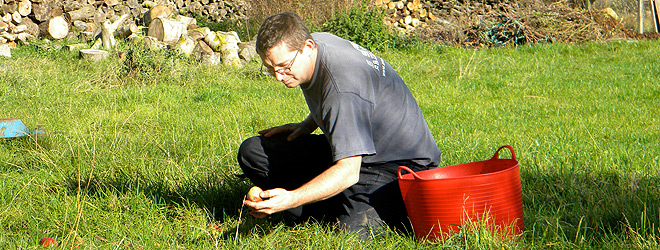More fearsome than Kendo Nagasaki* riding Godzilla**, the very mention of it’s name can cause widespread pant-wetting amongst property holders and allotmenteers alike. Once established, should we down spades and flee to the hills? Is there anyone out there who can save us from this evasive menace?
We chat to those with the answers…
So, where did this herbaceous marauder come from? We can hazard a guess, but please fill us in.
The fast growing plant was first introduced to the U.K. as an ornamental plant from Asia. Despite its good looks, Japanese knotweed soon gained a bad reputation as it escaped from gardens spreading throughout the country.
Interestingly, the plant doesn’t cause such problems in Japan where it is controlled by the natural predators that include about 200 species of plant-eating insects and 40 species of fungi.
It looks like bamboo. What’s the problem?
The worst thing about the knotweed is that it can grow a metre a month overwhelming other plants as well as damaging roads, pavements, and buildings, which brings significant losses. The plant itself doesn’t produce seed but reproduces itself through long rhizomes and root segments that move together with dirt and water ready to produce new plants.
In addition to this, Japanese knotweed tends to dry during its dormant growth stages creating a serious fire hazard throughout the country.
OK, I think It’s invaded my property and I want it banished. What are my options?
Even though Japanese knotweed removal is quite difficult and costs the U.K. economy about £150 million a year, there are effective methods of taking the plant under control. If you have noticed the plant on your property, click here for help with Japanese knotweed eradication or read on.
Non-chemical control methods
Non-chemical Japanese knotweed control methods include cultural control methods such as digging out and destroying the roots. However, these methods don’t prove to be very effective as it takes several seasons to get rid of all the weed parts. Besides, knotweed disposal is regulated according to the Environmental Protection Act 1990.
Biological control is based on using the psyllid Aphalara itadori, a plant-eating insect which is currently under trial on a small selection of areas and not yet available for gardeners.
Chemical control methods
Chemical knotweed control methods are based on destroying the weed with chemical substances such as herbicides. Herbicide treatments include foliar sprays and stem injections which are really cost-effective and can be applied according to your property requirements. When applied by certified specialists, chemical control methods are very effective and safe for the environment.
Before ordering eradication, it’s advisable to run a thorough site survey to determine which knotweed control method is the most suitable for your property. The survey includes studying individual environmental factors as well as the severity of property infestation. Depending on the method, it may take several seasons to eradicate the weed completely.
So what’s the outlook?
Even though biological knotweed control may take five to 10 years to make a difference, experts are optimistic about using Japanese natural predators to get rid of the invasive species. Wildlife minister Huw Irranca-Davies commented, “These tiny insects, which naturally prey on Japanese knotweed, will help free local authorities and industry from the huge cost of treating and killing this devastating plant”.
*Not Japanese as claimed, but a native of Stoke-on-Trent.
**Most definitely Japanese. More Japanese than anything else you could name.
This is a sponsored post








I think most people at this point have realised that knotweed isn’t something we’ll ever likely get rid of in the UK. The psyllids which are being trialled to try and combat knotweed should help slow its growth, which should naturally help to reduce the vast sum of money being spent on combating it at the moment.
It has to be said that this is a rather tasty edible. I know non-native invasive species are not pleasant or wanted, but perhaps you could get a good meal or two out of it? Foragers in the US delight in a good knotweed dinner.
You can also dunk the young shoots in a bottle of vodka to make a tasty liqueur…
Have a Knotweed issue? Check out Forage, Harvest, Feast by Marie Viljoen. Published by Chelsea Press, USA. She has recipes for the invasive.
She speaks of them being a cross between rhubarb and sorrel when eaten raw. SOUR.
This spring, I shall try Knotweed pickles and, perhaps a cream and knotweed sauce. ( most things taste great in cream).
Apparently, if you cut it down religiously each year you might collapse the plant in time.